
Brad Pitt's Make It Right Foundation (remember THE PINK PROJECT?) has sent us first images of the new home Frank Gehry designed for the initiative. Completed this week, the building is located in New Orleans' Lower 9th Ward, the neighborhood most devastated by Hurricane Katrina back in August of 2005. To date, this is the only Gehry-designed home in Louisiana, and—complying with Make It Right's core mission—built to LEED Platinum certification standards.
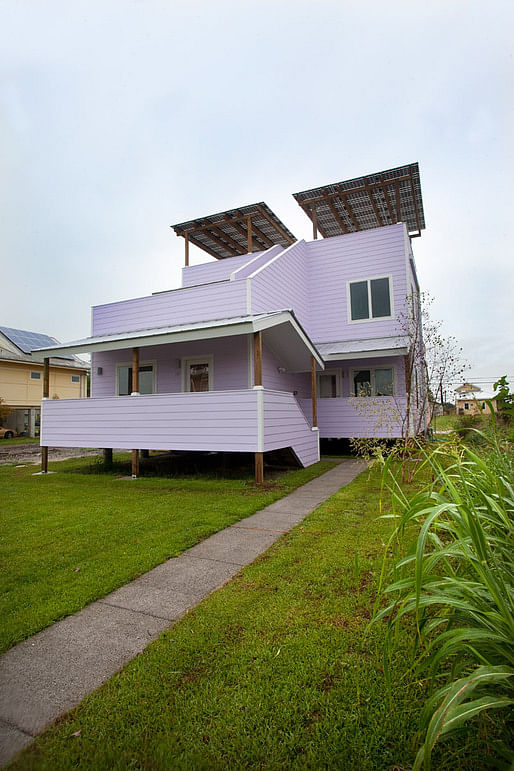
Here's the official press release we've received from Make It Right:
July 13, 2012, New Orleans – Make It Right, founded by Brad Pitt to build sustainable homes for communities in need, is proud to announce the completion of the organization's first home by renowned architect Frank Gehry. Gehry's duplex design was completed this week in New Orleans' Lower 9th Ward, the neighborhood most devastated by Hurricane Katrina. This home is one of only 22 Gehry residences in the United States and the only Gehry home in Louisiana.
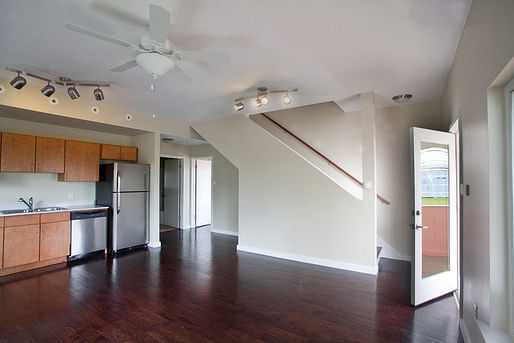
“I really believe in what Brad is doing for the community and was honored to be included,” said Frank Gehry. “I wanted to make a house that I would like to live in and one that responded to the history, vernacular and climate of New Orleans. I love the colors that the homeowner chose. I could not have done it better.”
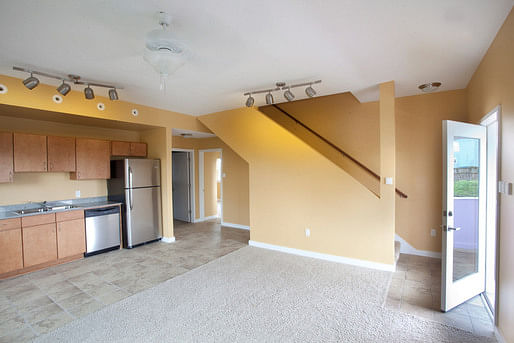
Design features of the 1780 square foot home include: front-to-back duplex organization allowing for maximum privacy between the homes, better flow of the interior spaces and a well-proportioned yard for each house; a waterproof solar canopy on the 510 square foot roof terrace and six additional canopied porches; open interior and exterior staircases; and oversized windows in the bedrooms.

The front house has three bedrooms and two bathrooms; the rear home has one bedroom and one bathroom. Bathrooms on both levels are stacked, staircases are stacked and the great room concept for living, dining and kitchen were included in the design for construction efficiency.
All Make It Right's homes are built to LEED Platinum certification standards. Please see the attached list for selected sustainability features on this home.
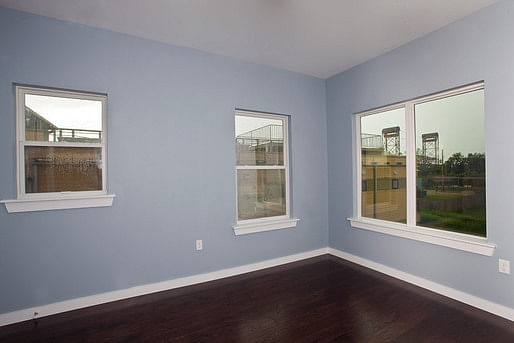
“Make It Right is so grateful to Frank and the team at Gehry Partners for designing this beautiful home,” said Tom Darden, Make It Right’s executive director. “Frank’s work proves that beautiful, elegant, ground-breaking designs can go hand-in-hand with the practical needs and culture of a community.”
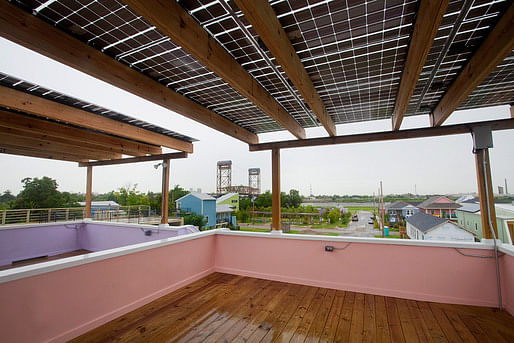
Make It Right’s Frank Gehry Home: Sustainability Features
Architects: Frank Gehry and Gehry Partners
1,780 square feet
Duplex design
Solar
Lumos LSX frameless solar modules produce clean energy from the sun and double as a waterproof canopy to provide shade on the two rooftop terraces. www.lumossolar.com
Metal Roofs
26 gauge metal roofs used on the lower porches absorb less heat, reduce the need to cool a home by at least 20 percent and require minimal maintenance.
Siding
NICHIHA fiber cement board siding is designed to last 50 years and withstand cracks, rot, hail damage and termites. www.nichiha.com
Framing lumber
ECOBLU wood, used in framing the home, is treated to resist moisture, mold, fungus, wood rot and wood-ingesting insects, including Formosan termites. www.ecob.net
Paint
Benjamin Moore’s Natura and Aura paints have zero VOCs and help create better air quality by eliminating off-gassing.
The exterior paint colors are Teacup Rose and Lily Lilac with Brilliant White trim. The interior colors of front home are Berber White, Manor Blue, Glowing Apricot and Sweet Daphne. The interior colors of the rear home are Roasted Sesame Seed, Kansas Grain and Manor Blue. www.benjaminmoore.com
Windows & Doors
Marvin Integrity All Ultrex Low-E windows from Gulf Enterprises help keep the home cool during the summer months and warm during the winter. www.gulf-enterprises.com
Cabinets
Legacy Cabinets use sustainably harvested wood and environmentally friendly production methods. www.legacycabinetsllc.com
HVAC
Unico System is a small-duct central heating and air conditioning system that utilizes compact, modular air handlers and flexible tubing to heat or cool the home. Unico System is 1/3 the size of conventional HVAC systems and can fit into smaller spaces, saving both material and labor costs. www.unicosystem.com
Tankless Waterheater
Noritz tankless waterheaters heat water instantaneously and are at least 80 percent more energy efficient than conventional heaters, reducing the homeowner’s annual water heating cost by about 50 percent. www.noritz.com
Countertops
ECO by Cosentino countertops and surfacing material are composed of 75% recycled raw material, including glass, mirror, porcelain and a corn oil resin. www.ecobycosentino.com
Hardwood Floors
Shaw EPIC Laminate Hardwood’s inner layer is made from post-industrial recycled content and uses approximately 50 percent less newly harvested wood than conventional alternatives. The wood flooring color is Wheel Wright Hickory.
www.shawfloors.com
Carpet
Shaw Green Edge carpet is made from post-consumer nylon and can be recycled into new carpet at the end of its lifecycle. The carpet color used throughout the home is Biscuit. www.shawfloors.com
All photos courtesy of Chad Chenier Photography / Make It Right
38 Comments
Shouldn't it be higher off the ground?
I don't see any interesting detail in this house, as it is a Gehry house.. The weather is so hot in New Orleans, and no shades in windows or any other areas but the rooftop (wich is way too hot to be used even with the solar panels shade, I think...). Having not much budget shouldn't mean having a regular house if it's designed by a good architect.
Best one yet! This is where the real talent and know-how shows. Lesson to all the other mostly contrived ones.
One of the best ones built for MIRF. So beautifully thoughtful for people who will live in them and it really shows Gehry's inimitable brilliance and wisdom... I am delighted he didn't resort to some "*Wow. Huh?" detailism and masturbating materiality. A total "*Huh? Wow!"
(*Ed Ruscha method of separating good art from the bad)
@Orhan Ayyüce
I'd say there are plenty of other ones there that are better. It's kind of absurd and even insulting to have Gehry even involved in something like this imho.
but... not knowing much about the whole situation, i have questions. he designed a duplex, which i'm guessing will house 2 families. will this design be replicated? why are they not building mass housing? this honestly looks like a luxury house to me, and i would like to know more details about the client/architect relationship and how is it that such large homes are being built through what i thought was sort of a charity organization. i would've thought the main impulse would be to help the larger population that lost their homes (although i know large amounts of the very poor have moved elsewhere). this not exactly a critique, but if anyone has more facts or could point in some direction it would be much appreciated.
I'm not the biggest fan of Gehry but this appears at first glance to be intelligently subdued. I agree that the detailing, particularly the climatic ones, looks sparse for the environment it is in. But for me the real winner is the composition, it doesn't appear as a duplex and the internal spaces look quite generous. I would love to see a section and some plans.
orhan - really? the best? i don't know. subdued is one thing, but this looks like a socal architect coming to design for the coast.
look, it hails down there. quite frequently. it's only a matter of time before those solar panels are toast being that horizontal. also, it rains. a lot. and very heavily most of the time. so, putting an outdoor stair/deck over the primary living space (and presumably a flat roof) is...questionable. not impossible, but on as tight a construction budget as this? i don't have a lot of faith it will hold up over time.
finally, for 4-5 months of the year, as locatix alludes to, is almost unbearably hot, muggy and flying insect laden. that rooftop piece could be very nice. a screened in porch would be nicer.
imho, the 'best' of the homes is actually one by one of the hometown designers - bild design. photo attached:
@Gregory Walker
I think you hit the nail right on the head. And your example fully fortifies why I feel this should be handled by local architects who have a connection to the community and context.
Agree 100%
I find the Gehry house to be gouge-your-eyes-out ugly. But I know, I know...beauty is overrated.
There are outlets for fans on the roof deck....
the metal roofs on the lower porches DO NOT reduce heating by 20% - it's the F*&%^&*^* shading. Argh...
It took 7 years for that? what?
I'd really like to see a plan of this house. I found "design boards" on the MIR website, but they're just photos of the model. The model does help explain the house's zoning much better than these official photos.
That Bild design is really nice - I love the screen descending past the porch, but if it's real buggy down there the screen should wrap the corner too, yes?
Also, the Gehry design is closer to a traditional-looking house than most of the MIR houses. I imagine a lot of potential owners will prefer that.
Nothing exciting or interesting about the Gehry design.
Overuse of material; All of the design features requiring double sided application of siding, adds considerably to the cost.
These homes should be materially efficient for affordability and need to be smaller, especially the foot print. True Green is less square footage
I hope these homes are deeply geo anchored and structurally tied all the way to the roof. It doesn't look like they are.
Roof top decks are generally out of the insect zone in most locales
The more and more I look at it, the more it reminds me of a west coast beach house
I think calling it best was little inviting of a provoked some typical Gehry rebuttal mostly usual stuff . I am sure everybody have their favorites. What I really like about Gehry's is that it captures all the appropriations well (social, formal, financial, contextual). That really separates his duplex and make it beautiful. It is a good rendition of top down and bottom up meeting at a sweet duplex. If you have the informed eyes about his genre, you can tell he learned his moments very well from his elders like Soriano, Schindler, Neutra.., and, he added great deal of Gehry on that pedigree. There are a lot of little lectures in that pink building.
We can agree to disagree, I am a naive youngin of course, I need to angst against something.
What most people may not be aware of is that Gehry's design as well as every other house designed for MIR including the local architects are not executed by the offices that generated the design.
All of the firms donate a well developed schematic design package and MIR's 'Architect of Record' continues the CDs, modifying them to the individual homeowner's requirements. My firm has several versions of our designs built there as well. So every iteration is a bit different and the design firms have some input but not much during construction. So in a sense, every version is slightly different and some the detailing and construction is better than others. These aren't meant to be "mass housing" for the "masses" but are really "affordable" custom homes for the returning homeowners that own those lots. Some of which have been in the same family since WW2. Each house is about $250K when it's all said and done but some of those houses cost a lot more on the first go-round.
That being said, MIR subsidized much of the construction costs early on because they literally had to train the local builders and tradespeople how to build to LEED and higher building standards than before. The cost per SF has dropped dramatically since the first iterations of the houses. MIR was also partly responsible for getting the domestic solar market here off and running after Katrina. One of the original project managers left and started his own solar company as a result.
As for answering Ultraspace's comment about hoping "these homes are deeply geo anchored and structurally tied all the way to the roof. It doesn't look like they are."
Every house is on concrete piers tied to grade beams tied to timber piles. These houses aren't going anywhere. Each house comes with a set of impact resistant fabric panels that cover the windows during storms. Every house has solar, HE HVAC, tankless water heaters. Wireless lighting systems. Some house incorporate SIPs or panelized construction, hurricane strapping, etc. Every house is also built above BFE (base flood elevation) which is approximately 3 ft. Some owners have elected to build higher than that and they pay for them.
There's a lot of technology in these houses that isn't apparent from the pictures and the homeowners are way beyond happy about their new homes.
Thanks for the post, iamus!
Would hurricane winds cause those solar panels to be ripped off though and couldn't termites get to the timber footings on the front?
" It is a good rendition of top down and bottom up meeting at a sweet duplex." Either way, talking about the process of building these homes, to the physical homes themselves, as "top down meeting bottom up" I do not find this Gehry example compelling at all. It, like nearly all of his buildings, is form driven, lacks any sort of attention to details on the interior, does a poor job dealing with context, and in the end, is process/form driven rather than appropriate architecture.
Guys, if you want to appreciate Gehry's design, go look at what happened to David Adjaye's. Ryan, if all they could do was SD, and someone else did everything else, what else were they supposed to focus on? I'm not a fan of the design either, but I think they did pretty well in designing something that could survive an Architect of Record, who was not chosen or supervised by Gehry.
thanks for the inside information iamus. it puts a different perspective on things. we are dealing with similar issues in japan now after the tsunami and working out how to manage land ownership issues as well as integrating new tech. it sounds like in NO the new homes are built for the original owners?
are you based in NO, or nearby? i am going to take trip there this fall and would like to talk to some people involved in the reconstruction process if possible. archinect doesn't let me contact you anymore, but if interested send me e-mail (william@frontofficetokyo.com)
i think its the 9th ward that is the main focus, right? its been a couple years since I visited...
Will,
For the most part, the aim of MIR was to get the original homeowners / landowners back home. The best way to put is they have 'right of first refusal' in building on their lot or selling it. Although I don't know of any that have sold theirs. There are also several houses that original homeowners rebuilt on their own and not through MIR. The neighborhood has become somewhat organic and more neighborhood-like than before when it was strictly "architectural porn" for us architects.
I am based in NO. I relocated here in 2009 from DC. Primarily because things slowed down in DC and I was forced to relocate. My wife's family is from South Louisiana and NO was one of the few places with lots of reconstruction work. It's slowed down some the last year and half but seems to be picking up again.
If you do come to NO, I'd be happy to meet up with you to talk. I'm interested in hearing how things are going in Japan with the rebuilding and all of the complex issues of people returning to their homes to rebuild.
I'll shoot you an email. Cheers.
I don't buy the architect of record argument, or any VE argument. Conceptual-Schematic design and the details should all be part of the package by the designer. If you don't work at the detail level and the schematic level, even if you aren't the "record architect" you aren't an Architect. Gehry, from his beginnings, of all people, should be able to work with a tight budget and really get some stellar interiors out of it. I know a bunch of firms who could have knocked this one out of the ballpark.
The front of the house seems a little uninviting and awkward.
And the solar panels if they can be unmounted for a storm, they'll have a better chance of lasting.
cheers iamus. that would be great.
not sure of all the hate for gehry, still. looks a decent enough project to me, not overdesigned nor starchitecty, which is fresh. i can't speak to the technical or financial side of things, though Iamus' description sounds pretty believable. the concept of letting owners have significant input is very cool.
By the way, what was called "the Pink Project" then was covered in Archinect in Dec, 2007 and there are some more information in that feature article.
Thank you for the link Orhan!
i think its great that Donna's BF without benefits, Brad Pitt, is doing what he's doing down in the NOLA. Kudos Brad! Looking at this house though, I think I'd trade the dueling roof decks for maybe a carport? As you may know it does rain like hell down here in the south y'all and being able to get the catfood and the kid inside without getting drenched is a good thang.
Ryan,
The 'Architect of Record' for MIR is John Williams Architects here in NOLA. They take the SD/DD package and then adopt that to the individual homeowner's requirements. As I said in my earlier post, every single iteration is slightly different from the previous iteration. There have also been a lot of issues with JWA as a result of how they "interpret" the design intent and details of the SD/DD packages they get from the design firms. And because JWA stamps those CDs, he has the liability. That's how MIR set it up unless it's changed in the last year or so. In fact JWA worked with Global Green and Brad on GG's Holy Cross Project before Brad split to do MIR and JWA went with him. MIR does a good job in keeping the design intent intact but sometimes the details do tend to fall through the cracks. And the homeowners ultimately picks out their fixtures and cabinets.
It's easy to criticize from afar, it is even easier to do so without knowing all of the complexities involved, even in what would appear to be a simple endeavor like MIR. But there was and still exists, a lot of outside scrutiny about the number of houses built, not built, why they're even bothering being built, why are they crazy designer houses, etc., etc. I'm certainly not defending any of the perceived failings at MIR but I do think it helps to understand that the MIR process isn't as straight forward as some would think.
Some homeowners don't elect to modify things that much. But believe me, the residential trades down here lack the level of sophistication that Gehry and other high profile architects might be used to having access to in other parts of the country. Throw in the "It's New Orleans" factor in dealing with the City and other departments that weren't or might not still be on board with everything being done and simple things like gray water recycling systems and cisterns can't get approval for one reason or another.
Needless to say, MIR is very much an experiment. Some houses have been very successful because they were designed to be straight forward and not complex. Others I think fail because they tried to be too much. Adjaye's house just doesn't work, Morphosis house is a great idea but falls flat when you see it in person I think, Shigura's house is conceptually strong but doesn't quite come through. A few of the local firms' houses are mixed bags as well.
Each time I take out-of-town friends or colleagues out there to visit, there are more houses that have been built so each time there's another version of a particular design that seems better executed.
Sorry I missed you iamus.
I did get to see the 9th ward and hit a tour from MIR because we are working on a similar project in tohoku. Impressive project though surreal in some ways. I found gehry's project to be quite good in person. Can't judge the others but they all held up to the last storm even the flat panels of gehry's design. Would love to hear more comments if any one with real knowledge has something to add shoot me a line.
A very impressive project. Congratulations!
5 decks ... is that some kind of status thing in Nawlins? Are there more on the back?
Fugly with a bad space plan. In other words typical Gehry.
Kudos to BP for leveraging his celebrity into a great cause.
yea this house is pretty unimpressive. maybe it will work well enough but it's very uninspired. Doesn't this indicate to us all the narrowness of gehry's design approach? there's nothing in his design ideas universal enough to translate into a modest dwelling. his designs are only made possible through enormous amounts of money. maybe this was just a back burner project that his office didn't spend any time thinking through to make beautiful.
the one gregory linked is gorgeous though.
Don’t think that the homes need to be historical replications, but do need to reference local vernacular and the New Orleans “porch culture”…close connections to the street and neighbors – not sky-decks…and building 150 homes….doesn’t equal 4,000 lost homes, not even with the new Common Core Math.
Applaud Brad Pitt’s initiative to explore new housing paradigms, but doing it against the backdrop of such a great tragedy is prone to backfire.
Block this user
Are you sure you want to block this user and hide all related comments throughout the site?
Archinect
This is your first comment on Archinect. Your comment will be visible once approved.